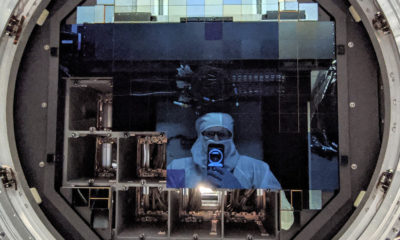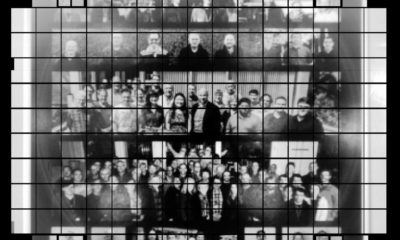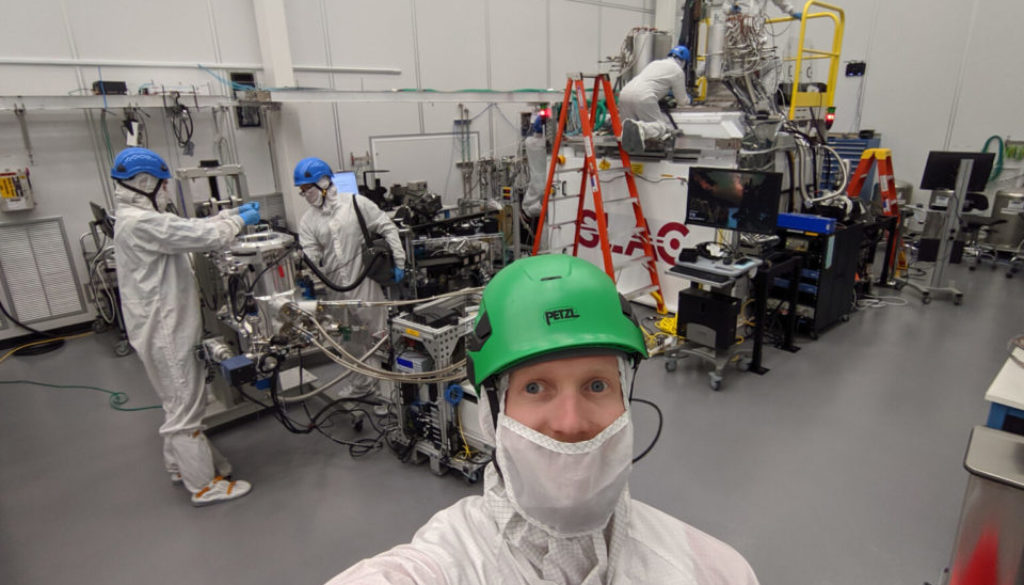Texas A&M Physics Graduate Andrew Bradshaw Offers Insight Into LSST Camera Experience
Earlier this month, crews at Stanford University’s SLAC National Accelerator Laboratory celebrated a major milestone in astronomy — the first 3,200-megapixel digital photographs taken with the world’s largest digital camera for the Vera C. Rubin Observatory Legacy Survey of Space and Time (LSST).
The collection of images, which are the largest ever captured in a single shot, represent a successful test of the LSST camera’s intricate focal plane completed at SLAC in January 2020. They are made possible by a dazzling array of imaging sensors — technology that 2009 Texas A&M University physics graduate and Kavli Institute for Particle Astrophysics and Cosmology (KIPAC) Postdoctoral Fellow Andrew Bradshaw has been focused on for more than a decade.

“I have been studying the camera sensors for the Rubin Observatory’s LSST camera ever since I left my physics undergrad at Texas A&M for my Ph.D. at UC Davis, also the Aggies,” Bradshaw said. “My thesis focused on using survey images for mapping mass in the universe, as well as how imperfect pixels and other hardware physics may result in incorrect cosmological measurements.”
During 10 years of operations starting late 2022, the National Science Foundation’s Rubin Observatory, together with the 3,200 megapixel U.S. Department of Energy-funded LSST camera and accompanying data facility, will carry out an unprecedented optical survey of the visible sky known as the Legacy Survey of Space and Time (LSST). The survey’s design is driven by four main science themes: probing dark energy and dark matter, taking an inventory of the solar system, exploring the transient optical sky and mapping the Milky Way.
Texas A&M astronomers Nicholas B. Suntzeff, Lifan Wang and Lucas Macri in the George P. and Cynthia Woods Mitchell Institute for Fundamental Physics and Astronomy have been part of the LSST project since its inception and are interested in using the telescope for their supernovae-related research. Suntzeff did the site survey that selected Cerro Pachón as the location for the Rubin Observatory in the 1990s, while Macri is a contributor to the LSST Science Book as well as a member of two LSST science working groups. In addition, the Munnerlyn Astronomical Instrumentation Laboratory, via Texas A&M astronomer Darren DePoy, is a longtime collaborator in and contributor to the telescope’s instrumentation and related devices.
Bradshaw credits Suntzeff as one of the reasons he’s ended up where he is today and says his Texas A&M education prepared him well for his current and future journeys. Among his most memorable moments, he cites a freshman summer research experience in physicist Hans Schuessler’s laser laboratory and a job in the physics machine shop that gave him unique hands-on skills, as well as a senior thesis on variable stars with Macri that helped him further hone his talents in research and data analysis.
“The physics and astronomy department at Texas A&M really has great people,” Bradshaw said. “I’m grateful to the many wonderful professors and staff for educating and inspiring me.”

After graduating from Texas A&M, Bradshaw pursued a Ph.D. at the University of California, Davis, where he first became involved in the LSST while working with astronomer J. Anthony Tyson on both LSST charged coupled devices (CCDs) and Deep Lens Survey data. Since fall 2019, Bradshaw has been working as a research associate with the SLAC LSST group on camera construction and commissioning. He has spent the past year helping to construct and adjust its full focal plane, which measures more than 2 feet wide and contains 3.2 billion pixels each about 10 microns wide. The focal plane itself is extremely flat, varying by no more than a tenth of the width of a human hair — a design that allows the camera to produce sharp images in very high resolution.
“I am very proud of what Andy has done, both in his Ph.D. and now working at SLAC on the LSST camera,” Suntzeff said. “He is part of one of the most exciting projects I have seen in my lifetime and will be for quite a while if he wants to be. He is a really great guy and a great example of a successful Aggie and astronomer.”
Once fully operational in late 2022, the LSST camera will be used to capture a portion of the sky about the size of 40 full moons and sufficient to allow the Rubin Observatory to image the entire Southern Hemisphere sky every few nights through five different color filters. From its perch atop the Simonyi Survey Telescope, the LSST camera’s imaging sensors will be capable of spotting objects 100 million times dimmer than those visible to the naked eye — a sensitivity that would let you see a candle from tens of thousands of miles away.
In the next few months, the LSST camera team will insert the focal plane detectors and cryostat into the camera body and add the camera’s lenses, shutter and filter exchange system. By mid-2021, the SUV-sized camera will be ready for final testing before it begins its journey to Chile. For now, however, Bradshaw is content to revel in the full-circle effect, noting that his current project is being studied and optimized using some of the same methods he learned as a Texas A&M undergraduate in 2008.
“I never thought I would be so lucky as to end up working on something so incredible as the LSST camera,” Bradshaw said. “I am very much looking forward to seeing what it sees! Texas A&M is a longtime partner in the LSST collaboration, which will be very useful once the fire hose of data starts up in a few years.”
Learn more about Bradshaw and his research or the Rubin Observatory’s Legacy Survey of Space and Time (LSST).
Find more information on undergraduate degree programs in the Texas A&M Department of Physics and Astronomy.
# # # # # # # #
About Research at Texas A&M University: As one of the world’s leading research institutions, Texas A&M is at the forefront in making significant contributions to scholarship and discovery, including that of science and technology. Research conducted at Texas A&M represented annual expenditures of more than $952 million in fiscal year 2019. Texas A&M ranked in the top 20 of the National Science Foundation’s most recent Higher Education Research and Development survey (2018), based on expenditures of more than $922 million in fiscal year 2018. Texas A&M’s research creates new knowledge that provides basic, fundamental and applied contributions resulting, in many cases, in economic benefits to the state, nation and world. To learn more, visit Research@Texas A&M.
-aTm-
Contact: Shana K. Hutchins, (979) 862-1237 or shutchins@science.tamu.edu; Dr. Andrew Bradshaw, (650) 926-3300 or bradshaw@slac.stanford.edu; or Dr. Nicholas B. Suntzeff, (979) 773-7000 or suntzeff@tamu.edu
The post Texas A&M Physics Graduate Andrew Bradshaw Offers Insight Into LSST Camera Experience appeared first on Texas A&M College of Science.
